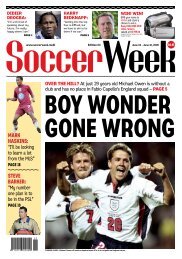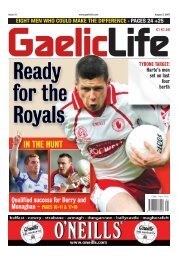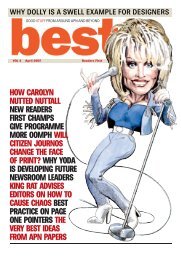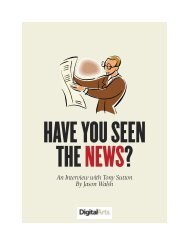Getting Back to Basics with Ed Arnold. - News Design Associates
Getting Back to Basics with Ed Arnold. - News Design Associates
Getting Back to Basics with Ed Arnold. - News Design Associates
- No tags were found...
Create successful ePaper yourself
Turn your PDF publications into a flip-book with our unique Google optimized e-Paper software.
CONVERSATION“I’ve oftenwonderedwhat wouldhappenif Ty Cobbhad everbeenasked<strong>to</strong> wearan ad.He’d say,’Nuts <strong>to</strong>you, Bud,I’m not awalkingbillboard,I’m abaseballplayer’”Sut<strong>to</strong>n: You’ve been in the newspaper business for 60years; are you happy <strong>with</strong> the way newspaper designhas evolved during that time?<strong>Arnold</strong>: I want <strong>to</strong> put on record that I’m not an oldreprobate longing for a return <strong>to</strong> the good old days. I’mmore of a proud father who is disappointed that hiskids are only reaching 98 percent of their potential andwants them <strong>to</strong> reach 101 percent. My message <strong>to</strong>young designers is this: look, kids, you can do better,but the only way <strong>to</strong> achieve your potential is <strong>to</strong> go back<strong>to</strong> – and understand – the basics. That sounds boring,but it’s reality.This last month I’ve been circulating among highschools around my home in Roanoke, Virginia, seeingthe football teams getting ready for the new season.They were doing exactly the same things I rememberseeing in the ’30s when I was in high school: basicblocking, basic ball handling, basic concentration ofwhat the aim is – <strong>to</strong> get the ball across the opponents’line. If I were involved in newspaper design <strong>to</strong>day, I’dfight <strong>to</strong> get back <strong>to</strong> basics, <strong>to</strong> convince everyone fromthe publisher down <strong>to</strong> the copyboy what our job reallyis. I’d love <strong>to</strong> do it, though. It’s exciting. It’s a challenge.It’s fun. And I can’t think of any other way of earninga living <strong>with</strong>out working for it.We’re living in a better age because we have a moreamenable mindset <strong>to</strong> new ideas. <strong>Design</strong> is recognized;you aren’t bound by the very rigid limitations of hotmetal. Pages are cheap <strong>to</strong> produce, and typefaces arecheap <strong>to</strong> produce – that’s why we are getting all theseGod-awful abominations. However, I do get a feelingwe are losing some of our concentration. I think thatmaking sure that the reader reads all our copy and –more important – comprehends it has become secondaryor almost entirely ignored. Display oftenbecomes more important than the message the edi<strong>to</strong>ris trying <strong>to</strong> sell.Sut<strong>to</strong>n: In what way?<strong>Arnold</strong>: Well, for example, I was looking at the DetroitFree Press display in its booth downstairs [in the SNDconference’s registration hall]. It has a bunch of beautifulfront page posters, the kind that my kids used <strong>to</strong>put on the wall when they were teenagers. Well, youget one of these pages, and you’re looking at it from 14inches, and it’s like standing in front of a circus poster,but it’s almost impossible <strong>to</strong> read. The front-pageimages on our newspapers are becoming so big thatthey don’t attract the reader, they attract the looker.And they often don’t work because the broadsheetpage is folded so you only see half of it in the newsrack. We are over-designing, and we are over-coloring,so that the reader is confronted by a three-ring circus.Who do I watch? The bareback riders, the weightlifteror the jugglers? I no longer see page patterns that leadmy eye through the page and tell me where <strong>to</strong> go. I callthese patterns the Gutenberg Principle. When I pickup a piece of printed paper, I go immediately <strong>to</strong> the <strong>to</strong>pleft-hand corner and when I get <strong>to</strong> the bot<strong>to</strong>m right I’mdone and I turn the page. That’s it! I’m also unhappy<strong>with</strong> putting ads on the front page. It reminds me of thedrivers in NASCAR and other au<strong>to</strong> races who arewalking billboards. Every square inch of the uniformis an ad.I’ve often wondered what would happen if Ty Cobbhad ever been asked <strong>to</strong> wear an ad. He’d say, “Nuts <strong>to</strong>you, Bud, I’m not a walking billboard, I’m a baseballplayer.”Sut<strong>to</strong>n: But surely advertising has always been an integralpart of newspapers?<strong>Arnold</strong>: Just before we got in<strong>to</strong> World War II, RalphIngersoll started a beautiful newspaper called PM. Ithad no ads, just journalism. Then the paper got somany complaints from readers that they started treatingads as news – ‘The big news <strong>to</strong>day is that Macy's isdoing this, Saks 5th Avenue is doing that,’ and so on.Then Ingersoll finally said, “This is advertising, let’sget some money for it.” Unfortunately, newsprintrationing came in, and Ingersoll didn’t have any previous-usebase point, so PM went under, which was ashame because it was a very handsome newspaper.But I believe advertising must be subordinate <strong>to</strong> newsand if you have <strong>to</strong> have it on page one, God forbid, putit down at the foot of the page, not at the <strong>to</strong>p. The higheron the page, the more importance it assumes, andI’d be damned if I’d let any ad be more important thanthe news.I redid the Bos<strong>to</strong>n Globe in the mid ’60s. At the timeadvertising filled a bit more than a quarter of the pageand I kept telling John Taylor, the publisher, “Getthose ads off, for Pete’s sake.” Well, he finally agreedand the ads disappeared as the contracts expired untilthere was only one left – about eight-inches deep bytwo columns wide. It was a beer ad that was predominantlya beautiful picture of Massachusetts, so it didn’tmar the page design at all. The day that ad disappeared,ABC announced that the Globe was the newNo. 1 paper in Bos<strong>to</strong>n. As soon as I heard this, I got onthe phone and said, “See, John, if you had taken myadvice earlier you’d have been No. 1 years ago.”There’s something a little tawdry about ads on pageone, but I’m sure we’re going <strong>to</strong> have <strong>to</strong> live <strong>with</strong> thembecause the trend is growing all the time.”Sut<strong>to</strong>n: Yes, the corporate bean counters aren’t going<strong>to</strong> back down on that one. Talking about bean counters,what do you think about the movement of North Americannewspapers <strong>to</strong> the narrow 50-inch web?<strong>Arnold</strong>: It’s stupid, incredibly stupid. What we are selling,basically, are square inches of printed material.We have a press that will print a certain width everytime it goes clunk. And we’re making it so it gives usless. But it costs just as much in electricity <strong>to</strong> run thepress, it costs just as much for the real estate the pressoccupies and everything else. It’s like taking a five-<strong>to</strong>ntruck and drawing a yellow line down one side and sayingthis is going <strong>to</strong> remain unused. Economically, I







